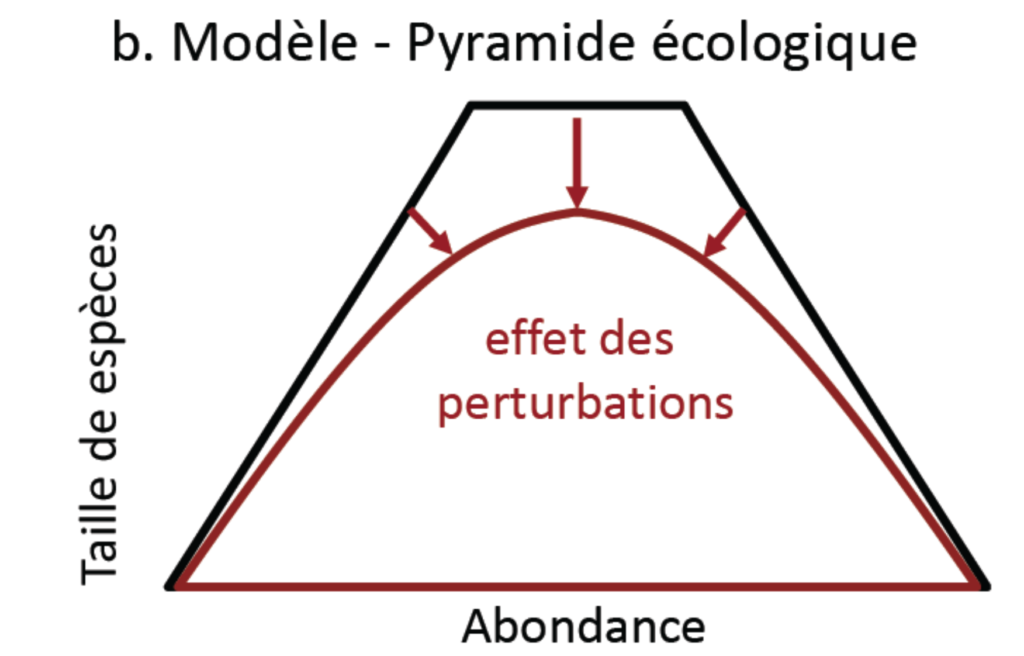Smaller organisms are typically more abundant than larger ones, which is a fundamental characteristic of ecological communities. How environmental pulse disturbances affect these « abundance pyramids » remains poorly understood. In a study recently published in Ecology Letters, researchers from iEES Paris and the University of Zürich showed that disturbances which are not size-selective still have a disproportionate impact on larger species, hence modifying the shape of abundance pyramids.
Key-words : ecological pyramid, organism body size, environmental disturbance
In the context of current global changes, understanding how ecological communities respond to environmental disturbances becomes crucial. A fundamental characteristic of ecological communities lies in the higher abundance of small organisms compared to larger ones.
These « abundance pyramids » are found both in terrestrial and aquatic communities. The position of organisms within these pyramids influences their ecological function as well as their vulnerability to anthropogenic and environmental disturbances. For instance, scientists studied in detail the consequences of fishing and overfishing on species abundances depending on their body size in marine ecosystems. However, there is no general understanding for other ecosystem and disturbance types.
Claire Jacquet, postdoctoral fellow in the « Community Ecology » group led by Florian Altermatt, Professor at the University of Zürich in Switzerland, and Isabelle Gounand, CNRS researcher in the team Ecology and Evolution of Interaction Networks of iEES Paris, showed that large species are much more sensitive to environmental disturbances compared to smaller ones. The more frequently disturbances occur, the higher the reduction of population abundances, while the extinction probability of large species increases. These effects modify species body size distribution within species communities.
Comparison theory-experiment
The scientists used two complementary approaches to study the dynamics of abundance pyramids. They first developed a simple mathematical model representing the dynamics of several co-occurring species populations. The model estimates the abundance and biomass of species communities submitted to destructive disturbances of varying frequency and intensity, affecting all species mortality in the same way.
In parallel, the scientists tested the effects of such disturbances on species communities in microcosms.
They studied aquatic communities composed of 13 protist species (unicellular organisms) and freshwater bacteria, with protist body-sizes varying over several orders of magnitude. They exposed the microcosms to disturbances of varying frequency and intensity, triggering peaks of mortality in species communities that mimics the effects of disturbances such as fires and hurricanes.
The scientists then measured the abundance and estimated the biomass of species with a semi-automated system of video analysis. Overall, the experimental results validated the mathematical model predictions. They showed that infrequent disturbances have a negligible effect on the shape of ecological pyramids, while more frequent or intense disturbances tend to lower pyramids’ height by provoking the extinction of the largest species (see figure).
The smaller organisms better resisted to disturbances.
Growth rate differences explain the results
The scientists explain these results with the following rationale: smaller organisms reproduce much faster than larger ones, which means the time between two of generations is shorter. The growth rate also determines the speed at which organisms can respond to changes in the environment. Subsequently, populations of large organisms need more time between two disturbances for their abundance to recover completely. If this time is too short, populations gradually decline through time. “These results can apply to a large number of realistic scenarios.
There is still a lot to do to integrate the complexity of ecological communities and better understand how disturbances affect their structure and functioning. This study sets some bases for this understanding, a key step to enable the mitigation of disturbance effects on ecosystems”, conclude Isabelle Gounand.

Contact: GOUNAND Isabelle, CR CNRS
Mél : isabelle.gounand@sorbonne-universite.fr
iEES Paris Communication :
iees_paris-com@upmc.fr






